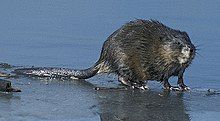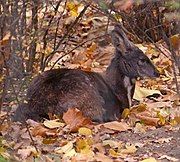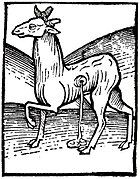User:Mykstor/sandbox
The word Musk originates from Sanskrit muṣká meaning testicle, is a misnomer as it pertains to a substance with a penetrating, effusive odor obtained from a special singular gland of the male musk deer which is located between the genitals and the stomach. This substance has been coveted for its aroma and fixative properties by both makers and wearers of perfumes since ancient times. Is one of the most expensive and now largely outlawed animal products in the world.
Nowadays, Musk in a broader sense refers to any number of substances, of natural origin or man-made, that elicit an approximation of the distinctive and archetypal smell of muscone, the essential chemical compound found in this gland or dried "pod" taken from the highly-endangered musk deer. Musk odorants of widely differing chemistry and origin are highly revered and nearly ubiquitous in modern perfumery. Musk odorants tend to be exceptionally tenacious, being what perfumers call very substantive. Musks impart a soft but highly effusive sensual warmth and finesse as well as strength and support to a fragrance composition's overall olfactory picture. Because musks tend to "underlie" floral, fruity, citrus and other aroma notes in a composition and often outlast them, they are often referred to as a base note. In fact, a noticeable musk component in a fragrance meant to worn close the the skin or in a lipstick is for many people exactly that effusive and "nose-filling" unknown "something" which causes them to describe what they're smelling as being a "real" perfume, as smelling or tasting "perfumey". [1]
Other sources of the musk aroma include glandular secretions from other animals, notably the endangered civet, which yields a macrocyclic ketone not very similar in basic structure" to muscone and called civetone, several plants emitting similar fragrances, notably ambrettolide from the seeds of abelmoschus as well as and man-made nature-identical and others not found in nature with similar aromas which expert "noses" classify subjectively as being part of the same olfactive family.
[2][3] Until the late 19th century, natural musk was used extensively in perfumery until economic and ethical motives led to the adoption of synthetic musk, which is now used almost exclusively.[4] The organic compound primarily responsible for the characteristic odor of musk is muscone.
Use of natural musk "pods", i.e. the dried deer glands, unfortunately still occurs in traditional Chinese medicine.
Natural sources
[edit]Musk deer
[edit]
The musk deer belongs to the family Moschidae and lives in India, Pakistan, Tibet, China, Siberia and Mongolia. To obtain the musk, the deer is killed and its gland, also called "musk pod", is removed. Upon drying, the reddish-brown paste inside the musk pod turns into a black granular material called "musk grain", which is then tinctured with alcohol. The aroma of the tincture gives a pleasant odor only after it is considerably diluted. No other natural substance has such a complex aroma associated with so many contradictory descriptions; however, it is usually described abstractly as animalic, earthy and woody[4] or something akin to the odor of baby's skin.[5]
Musk has been a key constituent in many perfumes since its discovery, being held to give a perfume long-lasting power as a fixative. Today the trade quantity of the natural musk is controlled by CITES but illegal poaching and trading continues.[5]
In Ayurveda, Musk has been considered as a life saving drug and used in various cardiac, mental and neurological disorders. It has also been included in various compound formulations like Kasturi Bhairav Ras, Kasturi Modak, Mrignabhyadi Vati and Mrigamadsar etc., which have wide therapeutic applications.
-
Moschus moschiferus, Siberian musk deer
-
"Musk-cat", woodcut from Hortus Sanitatis, 1490
Other animals
[edit]
Muskrat (Ondatra zibethicus), a rodent native to North America, has been known since the 17th century to secrete a glandular substance with a musky odor.[6] A chemical means of extracting it was discovered in the 1940s, but it did not prove commercially worthwhile.[6]
Glandular substances with musk-like odor are also obtained from the musk duck (Biziura lobata) of southern Australia, the muskox, the musk shrew, the musk beetle (Aromia moschata), African civet (Civettictis civetta), the musk turtle, the alligator of Central America, and from several other animals.
In crocodiles, there are two pairs of musk glands, one pair situated at the corner of the jaw and the other pair in the cloaca.[7] Musk glands are also found in snakes.
Plants
[edit]Some plants such as Angelica archangelica and Abelmoschus moschatus produce musky smelling macrocyclic lactone compounds. These compounds are sometimes used in perfumery as substitutes for animal musk or to alter the smell of a mixture of other musks.
The plant sources include musk flower (Mimulus moschatus), the muskwood (Olearia argophylla) of the Guianas and West Indies, and the seeds of Abelmoschus moschatus (musk seeds).
Man-made compounds
[edit]
Since obtaining deer musk requires killing the endangered animal, nearly all musk odorants used in perfumery today are synthetic. They are currently divided into four major classes according to their most basic chemical structure: nitro musks, polycyclic musks, macrocyclic musks and most recently, alicyclic or "linear" musks.[1][4] The first two classes have long found broad use ranging from fine [Perfumery|perfumery]] to cosmetics to fragrancing for laundry detergents, softeners and myriad other home and industrial products. However, the detection of certain members these two classes in human tissue and environmental samples together with concerns of putative carcinogenicity and/or neurotoxicity has led to scientific as well as heated lay debate resulting in a checkerboard of bans and restrictions in many regions of the world. The macrocyclic and linear musks which are in current use are considered to be biologically safe and environmentally friendly.[4]
- ^ a b Eh, Marcus (2004). "New Alicyclic Musks: The Fourth Generation of Musk Odorants". Chemistry & Biodiversity. 1 (12): 1975–1984. doi:10.1002/cbdv.200490151. PMID = 17191833 pmid = 17191833.
{{cite journal}}: Check|pmid=value (help); Missing pipe in:|pmid=(help) Cite error: The named reference "Eh" was defined multiple times with different content (see the help page). - ^ "Merriam-Webster's Online Dictionary: musk". Merriam-Webster. Retrieved 2007-04-07.
- ^ Chantraine, Pierre (1990). Dictionnaire étymologique de la langue grecque. Klincksieck. p. 715. ISBN 2-252-03277-4.
- ^ a b c d Rimkus, Gerhard G. (Ed.) (2004). "The Role of Musk and Musk Compounds in the Fragrance Industry". Synthetic Musk Fragrances in the Environment (Handbook of Environmental Chemistry). Springer. ISBN 3-540-43706-1.
{{cite book}}: Unknown parameter|coauthors=ignored (|author=suggested) (help) - ^ a b Rowe, David J. (Ed.) (2004). "Chapter 7. Aroma Chemicals IV: Musks". Chemistry and Technology of Flavours and Fragrances. Blackwell. ISBN 0-8493-2372-X.
{{cite book}}: Unknown parameter|coauthors=ignored (|author=suggested) (help) - ^ a b Groom, Nigel (1997). New Perfume Handbook. Springer. pp. 219–220. ISBN 0-7514-0403-9.
- ^ Wareham, D.C. (2005). Elsevier's Dictionary of Herpetological and Related Terminology. Elsevier Science. p. 129. ISBN 0-444-51863-0.



